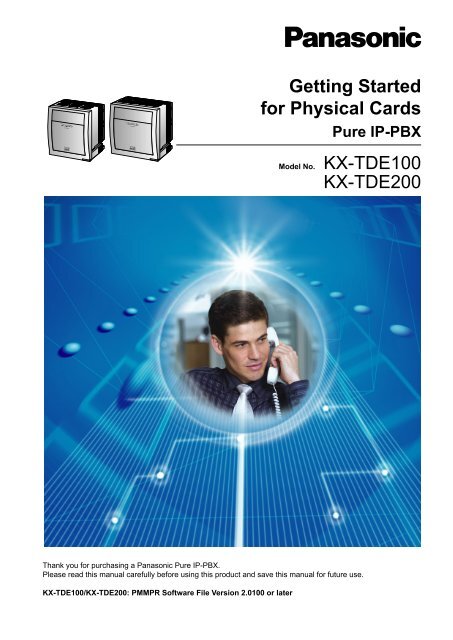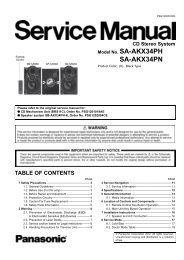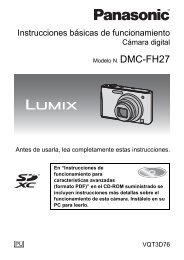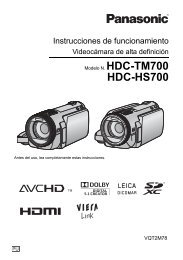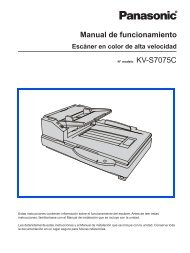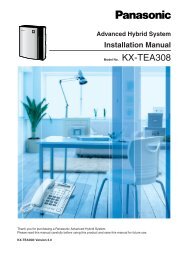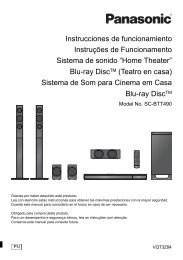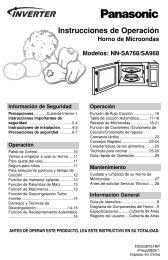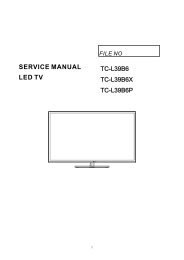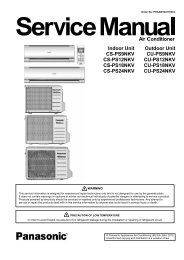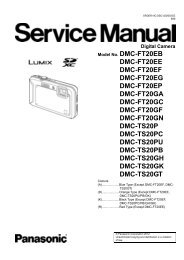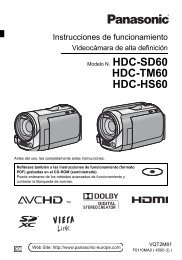Pure IP-PBX Getting Started For Physical Cards - Panasonic
Pure IP-PBX Getting Started For Physical Cards - Panasonic
Pure IP-PBX Getting Started For Physical Cards - Panasonic
Create successful ePaper yourself
Turn your PDF publications into a flip-book with our unique Google optimized e-Paper software.
<strong>Getting</strong> <strong>Started</strong>for <strong>Physical</strong> <strong>Cards</strong><strong>Pure</strong> <strong>IP</strong>-<strong>PBX</strong>Model No.KX-TDE100KX-TDE200Thank you for purchasing a <strong>Panasonic</strong> <strong>Pure</strong> <strong>IP</strong>-<strong>PBX</strong>.Please read this manual carefully before using this product and save this manual for future use.KX-TDE100/KX-TDE200: PMMPR Software File Version 2.0100 or later
Table of ContentsTable of Contents1 Before Installation ....................................................................................31.1 Safety Notices ...................................................................................................................41.2 System Connection Diagram ...........................................................................................51.3 Unpacking ..........................................................................................................................62 Installation ................................................................................................92.1 Opening/Closing the Front Cover ..................................................................................102.2 Inserting the SD Memory Card to the <strong>IP</strong>CMPR Card ....................................................112.3 Installing the Option Units .............................................................................................122.4 Installing the Trunk <strong>Cards</strong> ..............................................................................................142.5 Installing the Extension <strong>Cards</strong> (DLC8/DLC16/DHLC8/MSLC16/SLC8/SLC16/CSLC16) ...........................................................................................................................172.6 Connecting Extensions ..................................................................................................172.7 Frame Earth Connection ................................................................................................183 Before Programming .............................................................................193.1 Starting the <strong>PBX</strong> ..............................................................................................................203.2 Connecting the PC ..........................................................................................................213.3 Installing the Maintenance Console ..............................................................................224 Programming ..........................................................................................234.1 Programming the <strong>PBX</strong> ....................................................................................................245 Confirming the Connection ...................................................................295.1 Making and Receiving Calls ...........................................................................................302 <strong>Getting</strong> <strong>Started</strong> for <strong>Physical</strong> <strong>Cards</strong>
Section 1Before Installation<strong>Getting</strong> <strong>Started</strong> for <strong>Physical</strong> <strong>Cards</strong> 3
1.1 Safety Notices1.1 Safety NoticesPlease observe the safety notices in this manual in order to avoid danger to users or other people, and preventdamage to property.The notices are classified as follows, according to the severity of injury or damage:WARNINGThis notice means that misuse could result in death or serious injury.CAUTIONThis notice means that misuse could result in injury or damage to property.4 <strong>Getting</strong> <strong>Started</strong> for <strong>Physical</strong> <strong>Cards</strong>
1.2 System Connection Diagram1.2 System Connection DiagramLCOT4(KX-TDA0183)LCOT16(KX-TDA0181)LCOT8(KX-TDA0180)DLC16(KX-TDA0172)DLC8(KX-TDA0171)DHLC8(KX-TDA0170)DPTDSSConsoleKX-DT300/KX-T7600DPTKX-DT300/KX-T7600DPTKX-DT346/KX-DT343/KX-T7636/KX-T7633 DPTPCTelephoneCompanyPrivate<strong>IP</strong> NetworkAnalogueTrunkE & M LineISDN BRI Line(Digital Trunk)ISDN PRI Line(Digital Trunk)T1 Line(Digital Trunk)E1 Line(Digital Trunk)RouterCID/PAY8(KX-TDA0189)CID8(KX-TDA0193)DID8(KX-TDA0182)E&M8(KX-TDA0184)BRI4(KX-TDA0284)BRI8(KX-TDA0288)PRI30(KX-TDA0290CE/KX-TDA0290CJ)PRI23(KX-TDA0290)T1(KX-TDA0187)E1(KX-TDA0188)<strong>IP</strong>-GW4E(KX-TDA0484)<strong>IP</strong>-GW16(KX-TDA0490)CSLC16(KX-TDA0177)MSLC16(KX-TDA0175)SLC16(KX-TDA0174)SLC8(KX-TDA0173)EXT-CID(KX-TDA0168)<strong>IP</strong>-EXT16(KX-TDA0470)OPB3(KX-TDA0190)DPH4(KX-TDA0161)DPH2(KX-TDA0162)EIO4(KX-TDA0164)ECHO16(KX-TDA0166)MSG4(KX-TDA0191)ESVM2(KX-TDA0192)SLT(DHLC only)Wireless Phone(DHLC only)SLTDoorphone & Door OpenerExternal Sensor/External Relay DeviceAPT(DHLC only)LANVoiceProcessingSystemFaxMachine<strong>IP</strong>-PTPT-interface CS<strong>IP</strong> SoftphonePSBatteriesStation Message DetailRecording (SMDR)PSU-S/PSU-M/PSU-L(KX-TDA0108/KX-TDA0104/KX-TDA0103)ESVM4(KX-TDA0194)CSIF4(KX-TDA0143)CSIF8(KX-TDA0144)CSPS<strong>IP</strong>CMPR(Installed by default)PCRMT(KX-TDA0196)DSP16(KX-TDE0110)DSP64(KX-TDE0111)RadioAmplifierPager/SpeakerPrivate <strong>IP</strong>NetworkRouterWANITSP* 1 DCE* 2Network(e.g., ADSLModem)RouterVirtualTrunk SlotV-<strong>IP</strong>GW16V-S<strong>IP</strong>GW16VirtualExtension SlotV-<strong>IP</strong>EXT32V-S<strong>IP</strong>EXT32Mountable EquipmentLAN<strong>IP</strong>-PT<strong>IP</strong> SoftphoneS<strong>IP</strong> ExtensionPCCTI Server*1ITSP: Internet Telephony Service Provider*2DCE: Data Circuit Terminating Equipment<strong>Getting</strong> <strong>Started</strong> for <strong>Physical</strong> <strong>Cards</strong> 5
1.3 Unpacking1.3 UnpackingCheck the package contents.Main Unit ´ 1CD-ROM (including manuals, etc.) ´ 1AC Cord *1 ´ 1Screw A´ 3 (KX-TDE100)´ 4 (KX-TDE200)Screw B (Black)´ 2 (KX-TDE100)´ 6 (KX-TDE200)Anchor Plug´ 3 (KX-TDE100)´ 4 (KX-TDE200)Mini Plug (for pager and musicsource) ´ 4Ferrite Core (for the <strong>IP</strong>CMPRcard) ´ 2for KX-TDE100 for KX-TDE200 SD Memory Card ´ 1Metal Bracket ´ 1*1The type of the AC cord may vary depending on the country/area of use.The KX-TDE100BX/KX-TDE200BX is supplied with 2 types of AC cord. Please use whichever is appropriate for the country/area.In Canada, there is no ferrite core attached to the AC cord.NoteIn this manual, the suffix of each model number (e.g., KX-TDE100NE) is omitted unless necessary.6 <strong>Getting</strong> <strong>Started</strong> for <strong>Physical</strong> <strong>Cards</strong>
1.3 UnpackingNecessary items (not supplied):ü Telephone cable for extension connection:Diameter of cable(ø 0.4 mm to ø 0.6 mm)ø 0.5 mmø 0.5 mmø 0.5 mmMaximum length of cable1128 m for SLT720 m for KX-DT300/KX-T7600 series229 m for other DPT, APT and DSS ConsoleThe maximum length of the cable may vary depending on the type of cable and installation conditions.ü An RS-232C cross cable or Ethernet straight cable for PC connectionü Connectors (Amphenol/RJ45/BNC) for trunk and extension connectionsNote• The Ethernet straight cable should be a 10BASE-T/100BASE-TX CAT 5 (Category 5) or higher cable.• Use a shielded twisted pair cable for the Amphenol connector.• Use a twisted pair cable for the RJ45 connector.<strong>Getting</strong> <strong>Started</strong> for <strong>Physical</strong> <strong>Cards</strong> 7
1.3 Unpacking8 <strong>Getting</strong> <strong>Started</strong> for <strong>Physical</strong> <strong>Cards</strong>
Section 2Installation<strong>Getting</strong> <strong>Started</strong> for <strong>Physical</strong> <strong>Cards</strong> 9
2.1 Opening/Closing the Front Cover2.1 Opening/Closing the Front CoverOpening the Front Cover1. Insert a flathead screwdriver into the opening (on the left of the screw cover) and unlatch the screw cover.Turn the screw anticlockwise to loosen.2. Slide the front cover to the right until it stops, then lift the front cover.Closing the Front Cover1. Hook the front cover onto the shelf (line up the protrusions on the cover with the receptacles on the shelf),then slide the front cover to the left until it locks.2. Turn the screw clockwise to tighten, then secure the screw cover.2110 <strong>Getting</strong> <strong>Started</strong> for <strong>Physical</strong> <strong>Cards</strong>
SDCARDSDCARDSDCARD2.2 Inserting the SD Memory Card to the <strong>IP</strong>CMPR Card2.2 Inserting the SD Memory Card to the <strong>IP</strong>CMPRCardThe SD Memory Card contains software for all the processes of the <strong>PBX</strong> and all the customer data.The SD Memory Card must be inserted before startup.Example: KX-TDE2001<strong>IP</strong>CMPR Card2SDMemoryCard 34 5CAUTIONDo not remove the SD Memory Card while power is supplied to the <strong>PBX</strong>. Doing so may cause the <strong>PBX</strong> tofail to start when you try to restart the system.<strong>Getting</strong> <strong>Started</strong> for <strong>Physical</strong> <strong>Cards</strong> 11
2.3 Installing the Option Units2.3 Installing the Option UnitsSlot PositionInstall the power supply unit (PSU) into the PSU slot, and optional service cards into free slots.KX-TDE100KX-TDE200A PSU SlotB Null Slot *1C Free SlotsD <strong>IP</strong>CMPR Card*1Null slot is not available for any optional service card.CAUTIONTo protect the back board from static electricity, do not touch parts on the back board in the main unit,PSU, and on the optional service cards. To discharge static electricity, touch ground or wear an earthingstrap. Make sure the screws are tightened to earth the card securely.Installing the Power Supply Unit1. Insert the PSU along the guide rails.2. Push the release lever in the direction of the arrow, so that the PSU engages securely with the connectoron the back board.12 <strong>Getting</strong> <strong>Started</strong> for <strong>Physical</strong> <strong>Cards</strong>
2.3 Installing the Option Units3. Turn the 4 screws clockwise, in the order indicated by the numbers 1 to 4, to fix the PSU.Back BoardRelease Lever3 2Screws41Guide RailInstalling the Trunk/Extension <strong>Cards</strong>1. Insert the card along the guide rails.2. Holding the card as shown below, push the release lever in the direction of the arrow so that the cardengages securely with the connector on the back board.3. Turn the 2 screws clockwise to fix the card in place.Back BoardReleaseLeverScrewsGuide RailBe sure to cover each slot in which no optional service card is installed by using a Blank Slot Cover. <strong>For</strong> details,refer to "Covering the Blank Slots" in "3.2.7 Installing/Removing the Optional Service <strong>Cards</strong>" of the InstallationManual.<strong>Getting</strong> <strong>Started</strong> for <strong>Physical</strong> <strong>Cards</strong> 13
2.4 Installing the Trunk <strong>Cards</strong>2.4 Installing the Trunk <strong>Cards</strong>LCOT4/LCOT8/LCOT16 CardExample: LCOT 16 CardAmphenolTo trunkAccessories (included): Screws ´ 2User-supplied (not included): Amphenol connector14 <strong>Getting</strong> <strong>Started</strong> for <strong>Physical</strong> <strong>Cards</strong>
2.4 Installing the Trunk <strong>Cards</strong>BRI4/BRI8 CardExample: BRI8 CardTo attach the ferrite coreRJ45When using 1 or 2 cables:TX2(-)RX1(-)RX2(+)TX1(+)LINE 1 toLINE 8When using 3 or 4 cables:To NT1Accessories (included): Ferrite core(s) ´ 1 (BRI4 card) or 2 (BRI8 card)User-supplied (not included): RJ45 connectorCAUTION• <strong>For</strong> every 4 cables, use 1 ferrite core; aferrite core holds a maximum of 4 cables.• Attach the ferrite core as close to thecard’s connector as possible.Connect these optional service cards to the trunk through an NT1; do not connect to the U interface of thetrunk directly.NoticeWhen connecting the RJ45 connector, attach the included ferrite core.Note• LINE 5 to LINE 8 are for BRI8 card only.• These optional service cards have 100 W of terminal resistance. <strong>For</strong> use in point to multi-pointconnection, the cards must be placed at the end of the bus.<strong>Getting</strong> <strong>Started</strong> for <strong>Physical</strong> <strong>Cards</strong> 15
2.4 Installing the Trunk <strong>Cards</strong>PRI30/PRI23 CardExample: PRI30 CardTo attach the ferrite coreRJ45TX+TX-RX-RX+BNC (TX)TX+5 cmTo NT1To NT1TX-BNC (RX)RX-RX+<strong>For</strong> RJ45120Ω75ΩOR120Ω75Ω<strong>For</strong> BNCAccessories (included): Ferrite core ´ 1User-supplied (not included): RJ45 or BNC connectorsCAUTIONConnect these optional service cards to the trunk through an NT1; do not connect to the U interface of thetrunk directly.NoticeWhen connecting the RJ45 connector, attach the included ferrite core (except in Canada, where the ferritecore is not necessarily required).Note• In some countries/areas, the PRI30 card must not be connected to the Public Switched TelephoneNetwork.• Use only 1 type of connector (RJ45 or BNC) for connection of PRI30 card; RJ45 and BNC cannot beused simultaneously. Set the termination switch to 120 W (default) or 75 W for connector type to beused.16 <strong>Getting</strong> <strong>Started</strong> for <strong>Physical</strong> <strong>Cards</strong>
2.6 Connecting Extensions2.5 Installing the Extension <strong>Cards</strong> (DLC8/DLC16/DHLC8/MSLC16/SLC8/SLC16/CSLC16)Example: DHLC8 CardTo attach the ferrite core3 cmAmphenolTo extensionsAccessories (included): Screws ´ 2, Ferrite core ´ 1User-supplied (not included): Amphenol connectorNoteAttach the included ferrite core to the cable.2.6 Connecting ExtensionsExample: KX-T7600 Series DPTPin AssignmentsTO MAIN UNIT/ PABXDPT and DSS ConsoleH LAPTH LTo extension cardRJ11HTRLKX-T7000 Series SLTT R<strong>Getting</strong> <strong>Started</strong> for <strong>Physical</strong> <strong>Cards</strong> 17
2.7 Frame Earth Connection2.7 Frame Earth Connection1. Loosen the screw.2. Insert an earthing wire (user-supplied).3. Tighten the screw.4. Connect the earthing wire to earth.ScrewEarthingwireTo earthWARNING• Connect the frame of the <strong>PBX</strong> to earth.• Proper earthing (connection to earth) is very important to protect the <strong>PBX</strong> from the bad effectsof external noise or to reduce the risk to the user of electrocution in the case of a lightningstrike.CAUTION• <strong>For</strong> earthing wire, green-and-yellow insulation is required, and the cross-sectional area of the conductormust be more than 0.75 mm 2 or 18 AWG.• The earthing wire of the AC cable has an effect against external noise and lightning strikes, but it maynot be enough to protect the <strong>PBX</strong>. A permanent connection between earth and the earth terminal ofthe <strong>PBX</strong> must be made.18 <strong>Getting</strong> <strong>Started</strong> for <strong>Physical</strong> <strong>Cards</strong>
Section 3Before Programming<strong>Getting</strong> <strong>Started</strong> for <strong>Physical</strong> <strong>Cards</strong> 19
3.1 Starting the <strong>PBX</strong>3.1 Starting the <strong>PBX</strong>CAUTION• Before touching the System Initialise Switch, discharge static electricity by touching ground or wearingan earthing strap.• Once you have started the <strong>PBX</strong> and if you unplug the <strong>PBX</strong>, do not perform the following proceduresto start the <strong>PBX</strong> again. Otherwise, your programmed data will be cleared.• The power supply cord is used as the main disconnect device. Ensure that the AC outlet is locatednear the equipment and is easily accessible.• Use only the AC power cord included with the <strong>PBX</strong> for the PSU.NoticeNoteThe SD Memory Card must be inserted in the SD Memory Card slot of the <strong>IP</strong>CMPR card before startup.The <strong>PBX</strong> will continue to be powered even if the power switch is turned "OFF".1. Slide the System Initialise Switch to the "SYSTEM INITIALIZE" position.RUN IndicatorPowerSupply UnitSYSTEMINITIALIZETo ACOutletNORMALSystem Initialise Switch2. Plug the AC power cord into the <strong>PBX</strong> and an AC outlet, and turn on the <strong>PBX</strong>. The RUN indicator will flash.3. While the RUN indicator is flashing, slide the System Initialise Switch back to the "NORMAL" position.Depending on the configuration, initialisation takes about 1 min to 3 min. If successfully executed, theRUN indicator will stop flashing and stay lit.All data will be cleared and the <strong>PBX</strong> will be initialised to the default values. The DPTs should show the timeas 01:00.20 <strong>Getting</strong> <strong>Started</strong> for <strong>Physical</strong> <strong>Cards</strong>
3.2 Connecting the PC3.2 Connecting the PCThe Maintenance Console serves as an overall system programming tool for the <strong>PBX</strong>. The MaintenanceConsole’s Quick Setup lets you easily configure the <strong>PBX</strong> to receive intercom and trunk calls, as well as applybasic settings such as time and date.To programme the <strong>PBX</strong>, connect it to the PC via the MNT or RS-232C port.PC ConnectionMNT PortTo attach the ferrite corePCTo LAN PortTo COM Port3 cmPCRS-232C PortPin AssignmentsLAN (RJ45 Cable)LAN Port (PC) MNT Port (<strong>PBX</strong>)Pin No.1236Pin No.1236RS-232C (Cross Cable)COM Port RS-232C PortPin No.2345678Pin No.2345678CAUTIONWhen connecting a PC to the <strong>PBX</strong> via the RS-232C port, it is necessary to keep the following in mind toprotect the system:1. Make sure that both connector cases (frame ground) of the RS-232C cross cable (shielded cable) areconductive. If they are not conductive, make sure that both connector cases of the cable are firmlyconnected.2. If this is not possible, connect the frame of the <strong>PBX</strong> to the frame of the PC using an earthing wire inorder to prevent difference in the electrical potentials.NoticeWhen connecting a PC to the <strong>PBX</strong> via the MNT port, a fixed <strong>IP</strong> address must be assigned to the PC. <strong>For</strong>information about fixed <strong>IP</strong> addresses, ask your network administrator.<strong>Getting</strong> <strong>Started</strong> for <strong>Physical</strong> <strong>Cards</strong> 21
3.3 Installing the Maintenance Console3.3 Installing the Maintenance Console<strong>For</strong> the system requirements of the PC (e.g., operating system, hardware specifications), referto "4.3.1 Installing and Starting the Maintenance Console" in the Installation Manual.Note• Make sure to install and use the latest version of the Maintenance Console.• The contents and design of the software are subject to change without notice.• Microsoft product screen shot(s) reprinted with permission from Microsoft Corporation.1. Copy the setup file of the Maintenance Console to your PC.2. Double-click the setup file to run the installer.3. Follow the on-screen instructions provided by the installation wizard.22 <strong>Getting</strong> <strong>Started</strong> for <strong>Physical</strong> <strong>Cards</strong>
Section 4Programming<strong>Getting</strong> <strong>Started</strong> for <strong>Physical</strong> <strong>Cards</strong> 23
4.1 Programming the <strong>PBX</strong>4.1 Programming the <strong>PBX</strong>Starting the Maintenance Console and Assigning the Basic Items (QuickSetup)When you start the Maintenance Console with the Installer Level Programmer Code and connect to the <strong>PBX</strong>for the first time after initialisation (with the factory default setting), Quick Setup will launch automatically. DuringQuick Setup, you will set up the basic items. <strong>For</strong> details about the basic items, refer to "2.3.4 Quick Setup" inthe Feature Guide.1. Connect the PC to the <strong>PBX</strong> with an Ethernet straight cable or RS-232C cross cable.2. Start the Maintenance Console from the Start menu.3. "Information before programming" appears.a. Carefully read this important additional information, which includes updates to this and othermanuals.b. Click OK to close this window.4. a. Enter the Installer Level Programmer Code (default: INSTALLER).b. Click OK.5. Click Connect.6. a. Select KX-TDE100/200 from <strong>PBX</strong> Model.b. Select the LAN or RS-232C tab, depending on the type of PC connection with the <strong>PBX</strong>.c. Specify the settings as required.NoteWhen connecting to the <strong>PBX</strong> for the first time selecting LAN, the <strong>IP</strong> Address and PortNumber must be set to 192.168.0.101 and 35300 respectively.d. Enter the system password for installer (default: 1234).e. Click Connect.7. When country/area data do not match:a. Click OK to replace the country/area data of the <strong>PBX</strong>. Replacement may take several minutes tocomplete.b. Follow the procedure described in "Section 3 Before Programming" and restart the <strong>PBX</strong>.c. Repeat step 5 to reconnect the Maintenance Console to the <strong>PBX</strong>.8. Follow the instructions of the Quick Setup wizard and assign the basic items (Quick Setup).The system menu appears. You may now begin programming the <strong>PBX</strong>.24 <strong>Getting</strong> <strong>Started</strong> for <strong>Physical</strong> <strong>Cards</strong>
4.1 Programming the <strong>PBX</strong>Assigning the BRI Setting (Automatic Configuration)1. a. Under Configuration, click Slot.b. Move the mouse pointer over the BRI card.A menu will be shown under the mouse pointer.c. Click Ous to set the card to out-of-service status.2. Click Tool ® BRI Automatic Configuration from themenu bar.3. a. Click Check to turn on the BRI card.b. Click OK.4. a. Enter the subscriber number for the desired ports inSubscriber.b. Click Execute.NoteNetwork settings are automatically set.c. Click Check Box of the desired ports.d. Click Data Apply.e. Click Close.5. a. Under Configuration, click Slot.b. Move the mouse pointer over the BRI card, then clickINS to set the card to in-service status.<strong>Getting</strong> <strong>Started</strong> for <strong>Physical</strong> <strong>Cards</strong> 25
4.1 Programming the <strong>PBX</strong>Assigning the Incoming Trunk Call Destination<strong>For</strong> analogue trunk users (DIL Setting):1. Under CO & Incoming Call, click DIL Table & PortSettings.2. Confirm that the DIL tab is selected.3. Configure the settings as required.4. Click OK.<strong>For</strong> ISDN trunk users (DDI Setting):1. Under CO & Incoming Call, click DDI / DID Table.2. Configure the settings as required.3. Click OK.<strong>For</strong> ISDN trunk users (MSN Setting):1. Under CO & Incoming Call, click DIL Table & PortSettings.2. Click the DDI / DID / TIE / MSN tab.3. Set the Distribution Method of the desired ports toMSN.4. Click OK.5. Click MSN Table.6. Click the MSN tab.7. Configure the settings as required.8. Click OK.26 <strong>Getting</strong> <strong>Started</strong> for <strong>Physical</strong> <strong>Cards</strong>
4.1 Programming the <strong>PBX</strong>Setting an Extension Port to Use a DSS Console1. Under Configuration, click Slot.2. Move the mouse pointer over the desired extension cardto display the menu of options.3. Click Ous to set the card to out-of-service status.4. Move the mouse pointer over the card again, then clickPort Property.5. <strong>For</strong> DPT Type, set the Type to DSS and assign theLocation No.6. Click OK .7. Under Extension, click DSS Console.8. Select the desired pair extension number from PairExtension.9. Assign features to flexible buttons as required.10. Click OK.11. Under Configuration, click Slot.12. Move the mouse pointer over the card to display the menuof options.13. Click INS to set the card to in-service status.14. Click Close.<strong>Getting</strong> <strong>Started</strong> for <strong>Physical</strong> <strong>Cards</strong> 27
4.1 Programming the <strong>PBX</strong>28 <strong>Getting</strong> <strong>Started</strong> for <strong>Physical</strong> <strong>Cards</strong>
Section 5Confirming the Connection<strong>Getting</strong> <strong>Started</strong> for <strong>Physical</strong> <strong>Cards</strong> 29
5.1 Making and Receiving Calls5.1 Making and Receiving CallsMaking CallsTo call another extensionextension no.Off-hook.Dial extension number.Talk.To call an outside party9 / 0outsidephone no.Off-hook.Enter automaticline access number.Dial outside phonenumber.Talk.Receiving CallsOff-hook.Talk.30 <strong>Getting</strong> <strong>Started</strong> for <strong>Physical</strong> <strong>Cards</strong>
The KX-TDE100UK/KX-TDE200UK, the KX-TDE100NE/KX-TDE200NE, the KX-TDE100GR/KX-TDE200GR,and the KX-TDE100CE/KX-TDE200CE are designed to interwork with the:• Analogue Public Switched Telephone Network (PSTN) of European countries• Pan-European Integrated Services Digital Network (ISDN) using ISDN basic rate access• Pan-European Integrated Services Digital Network (ISDN) using ISDN primary rateaccess• ONP 2048 kbit/s digital structured leased lines (D2048S)<strong>Panasonic</strong> Communications Co., Ltd./<strong>Panasonic</strong> Communications Company (U.K.) Ltd. declares that this equipment is incompliance with the essential requirements and other relevant provisions of Radio & Telecommunications TerminalEquipment (R&TTE) Directive 1999/5/EC.Declarations of Conformity for the relevant <strong>Panasonic</strong> products described in this manual are available for download byvisiting:Contact to Authorised Representative:<strong>Panasonic</strong> Testing Centre<strong>Panasonic</strong> Marketing Europe GmbHWinsbergring 15, 22525 Hamburg, Germanyhttp://www.doc.panasonic.de
1-62, 4-chome, Minoshima, Hakata-ku, Fukuoka 812-8531, JapanCopyright:This material is copyrighted by <strong>Panasonic</strong> Communications Co., Ltd., and may be reproduced for internal useonly. All other reproduction, in whole or in part, is prohibited without the written consent of <strong>Panasonic</strong>Communications Co., Ltd.<strong>Panasonic</strong> Communications Co., Ltd. 2007PSQX4416XAKK0607CH2108


